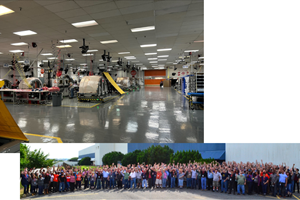Seeing the C Series deal in context: Borderless bargaining in a global marketplace
On Oct. 16, Airbus SE (Toulouse, France) and Bombardier Inc. (Montreal, ON, Canada) jointly announced that they will become partners on the latter’s C Series aircraft program.
On Oct. 16, Airbus SE (Toulouse, France) and Bombardier Inc. (Montreal, ON, Canada) jointly announced that they will become partners on the latter’s C Series aircraft program. Airbus will acquire a slight (50.01%) majority interest in CSALP, the legal entity that actually builds the C Series planes. The C Series primary assembly line will remain in Québec, but additional C Series work will be added at the Airbus manufacturing site in Mobile, AL, US.
Although initially surprising, I’ll argue here that it shouldn’t be. It was yet another sign that in markets with global reach — air travel is certainly one — economic and competitive realities seem inevitably to take precedence over local politics and parochial loyalties. Consider first that this deal has enabled Airbus to acquire, rather than having to re-imagine, design and then build, a plane in the 100- to 150-seat range that is a fitting complement to its A320neo in a single-aisle passenger jet market for which Airbus is best prepared in the single-aisle market’s higher end (150-240-seat range). Likewise, Bombardier, facing the daunting prospect of having to sell its C Series planes into a huge, expanding global marketplace dominated by Airbus and Boeing, now will have the strength and reach of the Airbus marketing machine behind its product, almost ensuring the C Series an enviable share of the lucrative single-aisle market.
And lucrative it will be. The single-aisle category, by all accounts will make up 60-70% of the global demand from airlines for commercial aircraft in the foreseeable future. And given the demanding production schedule that will no doubt result, Bombardier will be able to count on the Airbus supply chain to ensure materials availability and timely delivery, and to do so at significant C Series production cost savings.
Such international dealmaking isn’t unprecedented, of course. Despite the current mood in the White House, much of US-based Boeing’s (Chicago, IL, US) midsize, twin-aisle 787, for example, is made outside the US, because Boeing, too, despite strong “made in America” campaigns waged on the US political stage for decades, sought suppliers outside its “home” country to encourage sales of its groundbreaking composite-airframed jet, particularly in Japan and the then new and sure-to-grow air-travel market in China.
Whatever one might think of you-scratch-my-back-and-I’ll scratch-yours dealmaking, it’s a result of a political sensibility that sees beyond borders to the wisdom of rightly reading economic realities. It’s about everyone wanting their share of the pie, to be sure. But that’s not all it is. Ultimately, the goal, as Airbus CEO Tom Enders declared at the time of the Airbus/Bombardier announcement, is “a win-win for everybody!” For the composites industry, this sort of international web-building certainly has been a win. It’s spread our technology to places it might not otherwise have gone, or not nearly so quickly as it has. It’s done so at a technologically high level as well. And it’s one very big reason why composites have progressed, in two short decades, from a largely Western European/North American game to a worldwide phenomenon.
This is not to say that companies like Bombardier and Airbus are immune to nationalistic influence. Both are, in fact, the beneficiaries of substantial native governmental subsidies — a fact that has aroused the ire of competitor Boeing, which does not so benefit. Boeing, however, has made news in recent years for how little it has paid in US corporate income taxes (seen by critics as a subtle form of governmental subsidy).
Yet it is difficult, in the context of the “borderless” global economic expansion we’ve witnessed, to imagine how cries of “America First!”, “Brexit!” and threats of tariffs and trade pact pullouts that pit peoples of one location or conviction against those of another offer much beyond sensational news footage and discord. Protectionism and nationalism, political stances that earned mixed reviews at best (and helped incite major warfare at worst) in their 20th Century incarnations, appear in this light not only unwise in the 21st Century but plainly counterproductive, not only for the aerospace industry and other global enterprises, but, more to our point here, also for the composites industry.
One need only consider the disconnect between the current US government’s desire to build a wall between Mexico and the southern US, and this country’s (and others’) business communities’ active investments in Mexican communities to develop new manufacturing bases, particularly for commercial aircraft. (One of many CW reports of such activity, an example from 2015, was titled, significantly, “GKN Aerospace Mexico facility gains Nadcap accreditation.”)
My point? Where markets are growing, those who flourish within them increasingly see national borders and political systems as challenging but negotiable obstacles on the way to global manufacturing and product sales arrangements that benefit all involved parties. Whether that appeals to one’s political preferences or not, it appears to be the source of more jobs in more places — that’s certainly been true in the composite industry — with far less discord than the alternative.
Related Content
How AI is improving composites operations and factory sustainability
Workforce pain points and various logistical challenges are putting operations resilience and flexibility to the test, but Industry 4.0 advancements could be the key to composites manufacturers’ transformation.
Read MoreComposites opportunities in eVTOLs
As eVTOL OEMs seek to advance program certification, production scale-up and lightweighting, AAM’s penetration into the composites market is moving on an upward trajectory.
Read MoreReducing accidental separator inclusion in prepreg layup
ST Engineering MRAS discusses the importance of addressing human factors to reduce separator inclusion in bonded structures.
Read MoreThe evolution, transformation of DEA from lab measurements to industrial optimization
Over the years, dielectric analysis (DEA) has evolved from a lab measurement technique to a technology that improves efficiency and quality in composites production on the shop floor.
Read MoreRead Next
Developing bonded composite repair for ships, offshore units
Bureau Veritas and industry partners issue guidelines and pave the way for certification via StrengthBond Offshore project.
Read MoreAll-recycled, needle-punched nonwoven CFRP slashes carbon footprint of Formula 2 seat
Dallara and Tenowo collaborate to produce a race-ready Formula 2 seat using recycled carbon fiber, reducing CO2 emissions by 97.5% compared to virgin materials.
Read MoreVIDEO: High-volume processing for fiberglass components
Cannon Ergos, a company specializing in high-ton presses and equipment for composites fabrication and plastics processing, displayed automotive and industrial components at CAMX 2024.
Read More






















